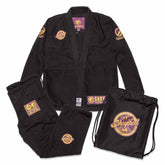Rock Climbing for BJJ: Grip, Strength, and Mobility Benefits
The Ultimate Cross-Training Tool for Brazilian Jiu-Jitsu Athletes
In the search for cross-training methods that genuinely elevate your Brazilian Jiu-Jitsu (BJJ) performance, few activities stand out like rock climbing. It may seem like a recreational outdoor sport. But it actually offers a treasure trove of benefits that translate directly to your performance on the mats. It is true especially when it comes to grip strength, pulling power, body control, and mobility.
It does not matter if you are a white belt finding your base or a seasoned competitor aiming for podium finishes. Integrating rock climbing into your training regimen could be a game-changing decision.
In this article, we will explore how rock climbing enhances your BJJ performance. We will examine the physiological overlap between the two. Moreover, we will try to provide practical training insights in this regard. This is not just another hobby. But it is a functional, tactical upgrade for grapplers.
Why BJJ Practitioners Should Consider Rock Climbing
Natural Synergy Between Rock Climbing and BJJ
Both rock climbing and BJJ emphasize precision, technique, and strategic body movements rather than brute strength. When you are climbing, you rely on leverage, core engagement, and muscular endurance. These are the same foundational principles that dictate your success on the mats.
The best climbers are not always the biggest or strongest. But they are the ones with exceptional body awareness, controlled breathing, and relentless grip endurance. Sound familiar? That is also the recipe for effective grappling.
Top Benefits of Rock Climbing for BJJ Athletes
1- Insane Grip Strength & Endurance
One of the most critical assets in BJJ, especially for Gi players, is a powerful, unrelenting grip. Rock climbing develops grip strength better than almost any gym-based workout. Since you are constantly crimping, pinching, and hanging with your fingers.
- Open hand strength from climbing mimics Gi grips (lapel, sleeve, and collar)
- Finger flexor endurance allows you to maintain grips longer during rolls
- Isometric grip tension helps with clutching your opponent’s sleeves or belt
Pro Tip: Bouldering walls with overhangs are especially useful for building dynamic grip resilience. It is a quality hard to train elsewhere.
2- Core and Posterior Chain Activation
In BJJ, your core and back muscles are involved in every major movement. Such as guard retention, sweeps, escapes, takedowns, submissions. Climbing builds these areas by requiring:
- Scapular retraction and depression (great for posture and back control)
- Rotational core engagement (useful in bridging, granby rolls, and shrimping)
- Stability under fatigue (helps during long scrambles or competition matches)
Climbers often develop the functional posterior chain strength. It helps stabilize movements during grappling. Thus, reducing injury risk and enhancing explosive transitions.
3- Enhanced Hip Mobility and Leg Dexterity
Climbers do not just use their arms. But they use every part of their body to move efficiently. In BJJ, hip mobility is key for:
- Playing guard (especially open or spider guard)
- Executing submissions like armbars and triangles
- Creating angles for sweeps
Climbing improves hip flexibility, knee control, and foot dexterity. Hence, helping you become a more agile and fluid grappler.
4- Improved Body Awareness (Proprioception)
Every climb is a puzzle. You are constantly adjusting your center of gravity, making micro-adjustments, and reading positions.
This high level of neuromuscular awareness transfers seamlessly to BJJ. In BJJ, feeling an opponent’s weight shift or setting a trap relies on subtle body mechanics.
Climbers learn to:
- Shift weight efficiently
- Control balance dynamically
- Use their full body in harmony
This results in smoother transitions and more efficient energy use in BJJ. These are key traits of high-level practitioners.
5- Mental Focus and Breathing Control
Both climbing and BJJ reward those who remain calm under pressure. Whether you are halfway up a route or stuck in bottom side control, your ability to:
- Stay composed
- Breathe deliberately
- Problem-solve under stress
...will dictate your success.
Rock climbing fosters mental resilience, just like BJJ does. It is not about brute force. But it is about executing calm, calculated moves under fatigue
Rock Climbing for Gi vs No-Gi Athletes
Gi BJJ Benefits:
- Finger and sleeve grip development
- Collar pull endurance
- Cross-grip transitions
No-Gi BJJ Benefits:
- Forearm and wrist control
- Overhook and underhook strength
- Clinch game improvements
Gi players benefit more directly from the gripping elements. However, No-Gi athletes still gain tremendous upper-body pulling power and grip endurance from climbing.
Scientific Backing: What the Research Says
Recent studies in sports science and functional fitness validate the crossover benefits of rock climbing:
- A 2022 study in the Journal of Strength and Conditioning Research found that elite climbers demonstrated superior finger flexor endurance, grip strength, and upper-body coordination compared to control athletes. All these are vital attributes in BJJ performance.
- An observational study of combat athletes showed that those who included rock climbing in their training had increased core stability, improved scapular control, and enhanced muscular endurance.
This evidence supports what many elite grapplers have discovered anecdotally i.e. climbing and BJJ are perfect training partners.
How to Integrate Rock Climbing into Your BJJ Training Routine
Frequency
- 1–2 sessions per week is sufficient for noticeable results.
- Avoid overtraining; climbing is taxing on the fingers and shoulders, just like BJJ.
Training Goals
- Endurance-focused climbs (longer, lower difficulty routes) for grip sustainability.
- Power-focused climbs (bouldering problems) for explosive pulling and dynamic movement.
Equipment & Safety
- Use liquid chalk to protect your hands and minimize skin damage.
- Focus on technique over power, especially early on, to avoid injury.
- Climb with a training mindset i.e. prioritize problem-solving and movement quality over reaching the top.
Real-Life Examples: Athletes Who Climb and Grapple
Many BJJ athletes cross-train with climbing and vouch for its benefits:
- Eddie Bravo’s 10th Planet community frequently discusses climbing in their forums as a supplement for No-Gi grip strength and scrambling.
- Clark Gracie and several other Gi competitors incorporate climbing walls or grip tools inspired by climbing to mimic lapel and sleeve grips.
From black belts to blue belts, the feedback is consistent. Thus, climbing sharpens your BJJ game.
Common Concerns and Misconceptions
1- “Won’t climbing overtrain my fingers?” It can, if you are careless. Use open-hand grips instead of aggressive crimping and avoid back-to-back days of intense grip training.
2- “I’m not a good climber. Will it still help?” Absolutely. You do not need to scale cliffs, basic indoor bouldering or top rope climbs will provide the benefits.
3- “Does it replace strength training?” Not entirely. Climbing is a phenomenal supplement. But you should still include foundational strength work like pull-ups, squats, and mobility drills.
Final Thoughts: Should You Start Rock Climbing for BJJ?
Without a doubt. Rock climbing is one of the best cross-training tools for grapplers. It targets all the key areas you need to dominate on the mats:
- Unbreakable grip
- Core-driven control
- Fluid hip mobility
- Mental composure
It is functional, fun, and far more engaging than repetitive gym routines. It never matters if you are prepping for your next tournament or just looking to enhance your BJJ lifestyle. Rock climbing deserves a spot in your training arsenal.
So next time you are off the mat—hit the wall.
Your grips, guard, and game will thank you.







